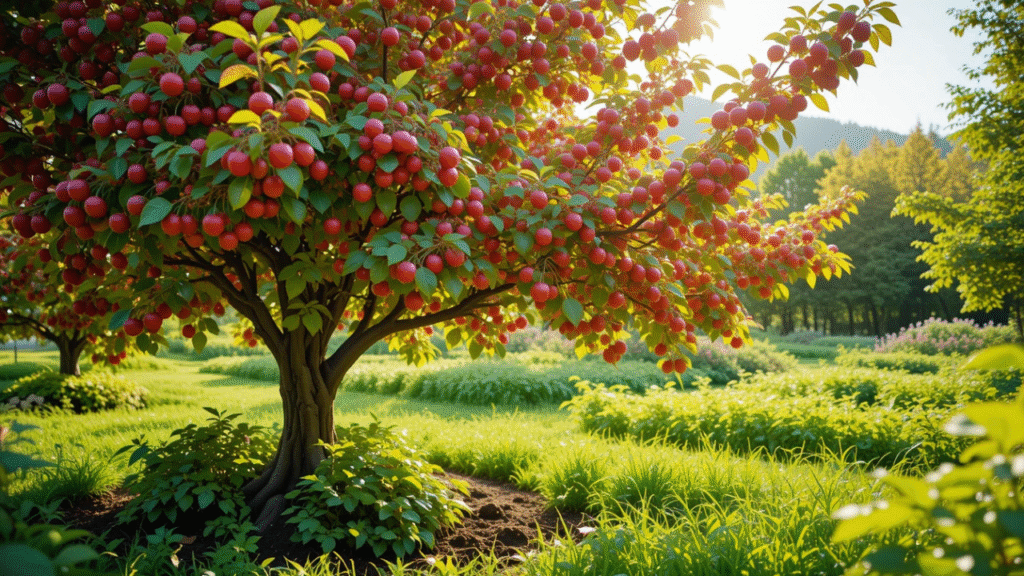
How to Keep Your Cherry Tree Free from Weeds and Overgrowth: Proven Tips for a Healthier Tree
🌸 Do you dream of a vibrant, fruit-laden cherry tree but find it constantly battling weeds and messy overgrowth? You’re not alone. Maintaining a clean, healthy space around your tree is crucial for its long-term growth and productivity. Weeds not only steal essential nutrients and water but also create a hiding place for pests and diseases. In this article, you’ll learn how to keep your cherry tree free from weeds and overgrowth using simple, proven methods that even beginner gardeners can follow. Let’s dig in and give your cherry tree the care it deserves! 🍒🌿
Table of Contents
Toggle🌱🚫🍒 Why Weeds and Overgrowth Are Harmful to Cherry Trees 🍒🚫🌱
Weeds and overgrowth might look like harmless greenery, but they can cause serious trouble for your cherry tree. Here’s why keeping the area clean and clear is so important:
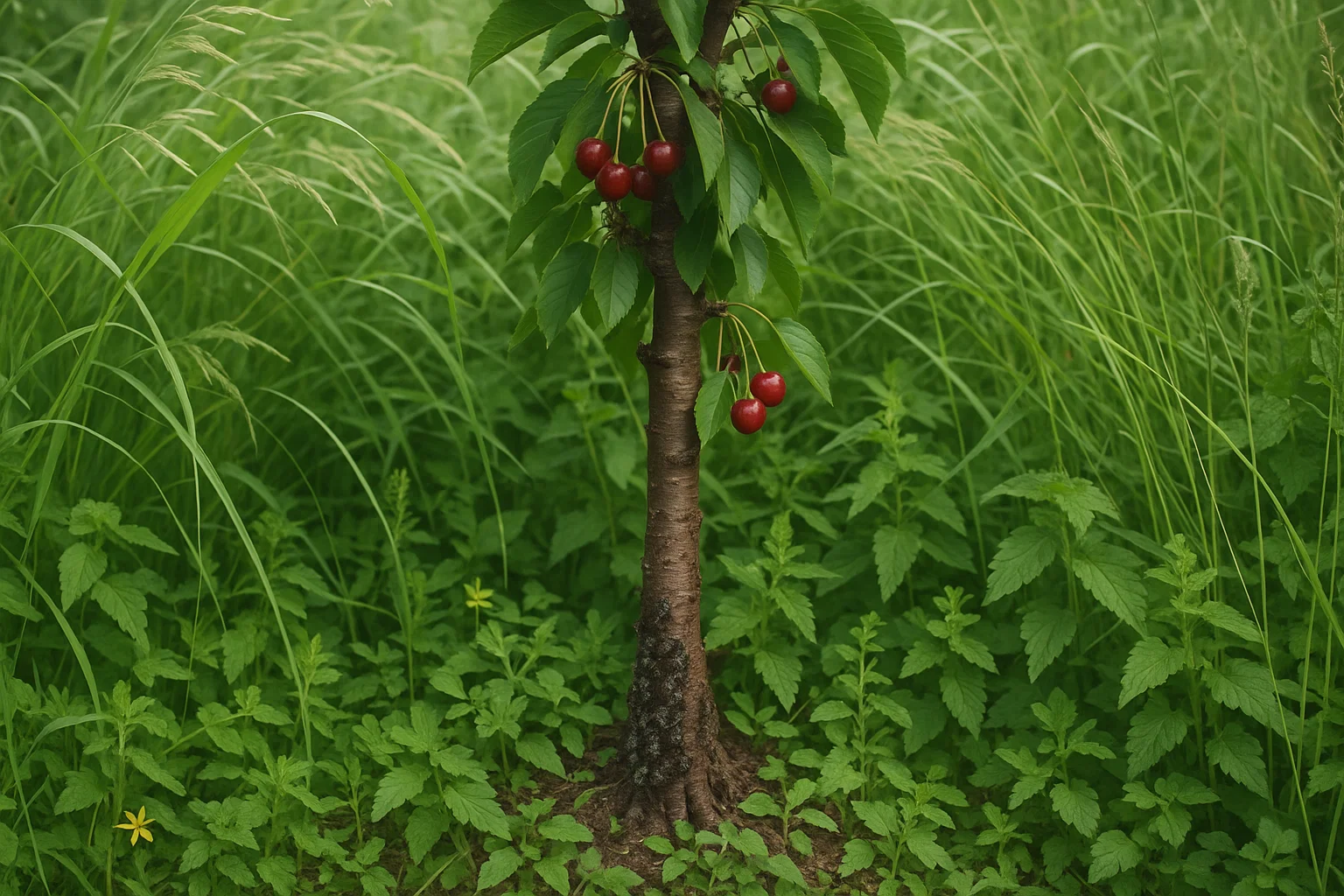
🌿 They Steal Vital Nutrients and Water
Weeds compete directly with your cherry tree for moisture and nutrients in the soil. This means your tree gets less of what it needs to grow strong and produce delicious cherries.
🌞 They Block Sunlight
Overgrown grass or nearby plants can shade your cherry tree’s lower branches, limiting the amount of sunlight it receives. Less light = slower growth and fewer fruits.
🐛 They Attract Pests and Spread Disease
Weeds and dense overgrowth create the perfect hiding spots for bugs, fungi, and harmful bacteria. These pests can quickly spread to your tree, damaging leaves, fruit, and roots.
🌧️ They Trap Moisture Around the Trunk
Excess moisture from thick weeds or tall grass can build up around the base of the tree, increasing the risk of rot and fungal infections.
🌸 Healthy Space = Healthy Tree
Keeping the area around your cherry tree weed-free not only boosts growth but also makes your garden look neat and beautiful. Your cherry tree will thank you with better blooms and sweeter fruit! 🍒💚
Keeping the area clear helps your tree grow strong, healthy, and full of juicy cherries! That’s why it’s important to understand how to keep your cherry tree free from weeds and overgrowth as part of your regular care routine.🍒✨
🌱🔍🍒 Identifying Common Weeds and Overgrowth Around Cherry Trees 🍒🔍🌱
Being able to identify common weeds and overgrowth is the first step in keeping your cherry tree healthy and free from competition. Here are some of the most common culprits that may be invading your garden:
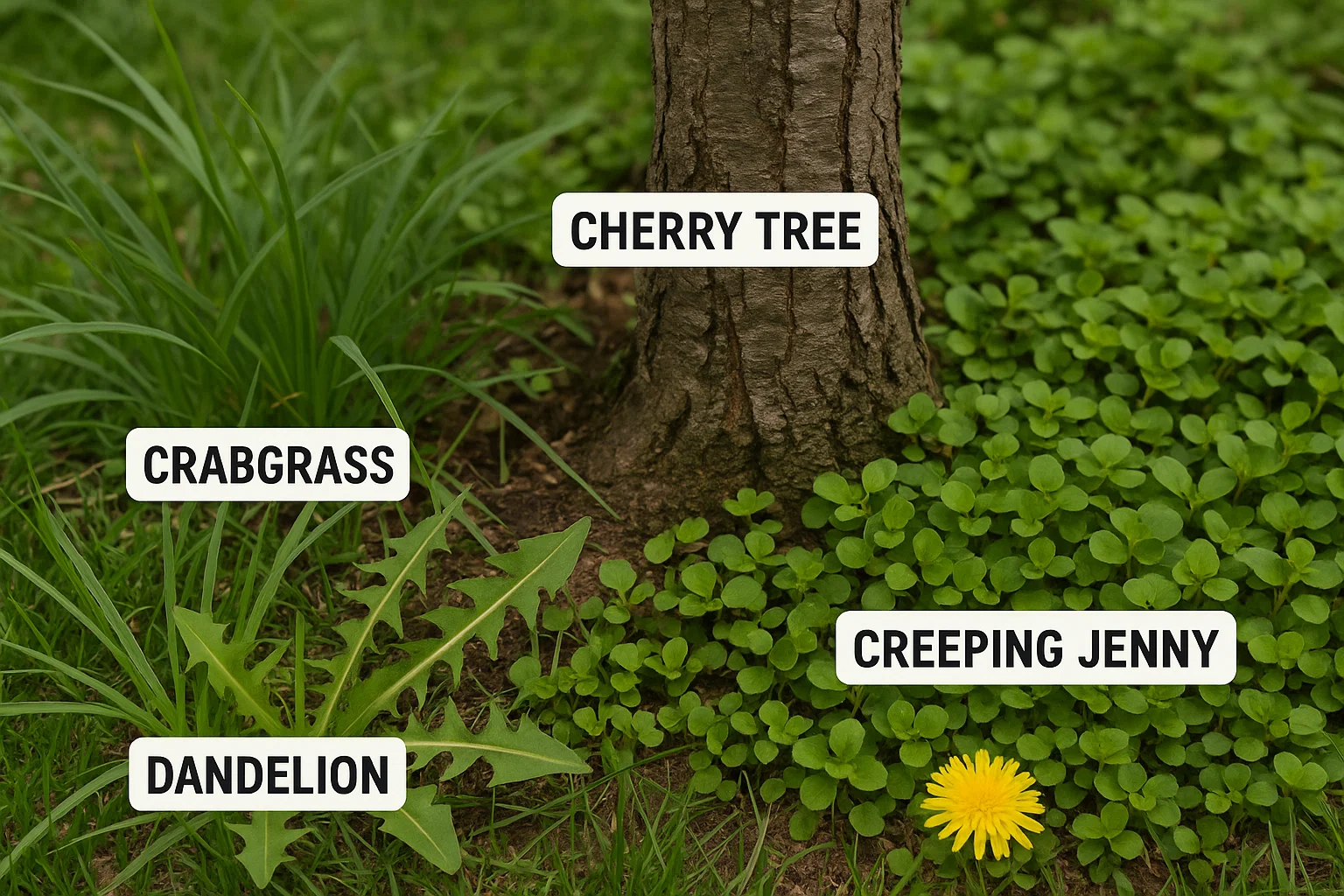
🌾 Dandelions 🌾
While their cheerful yellow flowers can brighten up a garden, dandelions have long taproots that steal vital nutrients and moisture from your cherry tree. If left unchecked, they spread quickly and crowd out your tree.
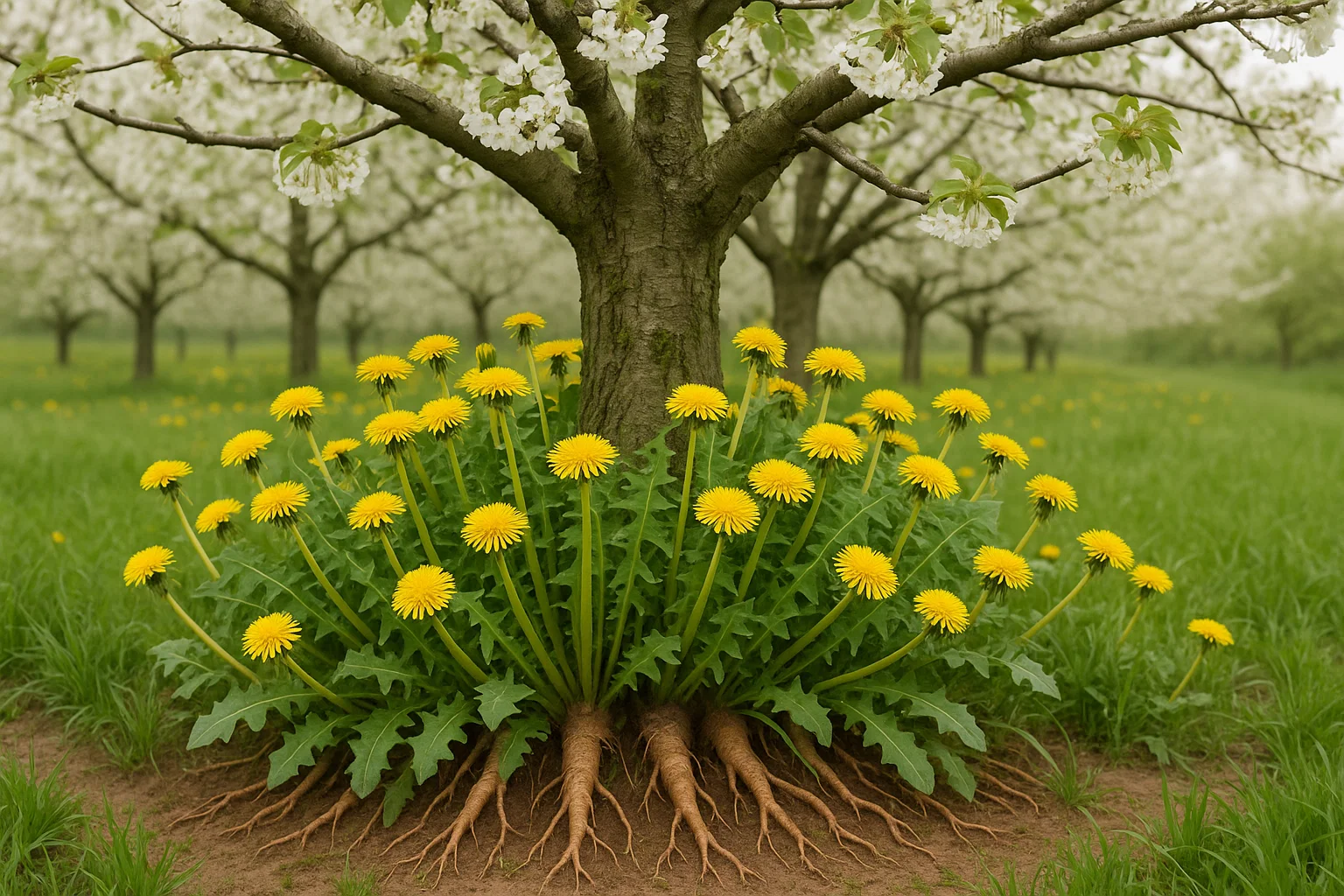
🌿 Crabgrass 🌿
Crabgrass is a fast-growing, low-maintenance weed that thrives in warm weather. It spreads rapidly, competing with your cherry tree for space, sunlight, and nutrients. It’s particularly stubborn once established, so early removal is key.
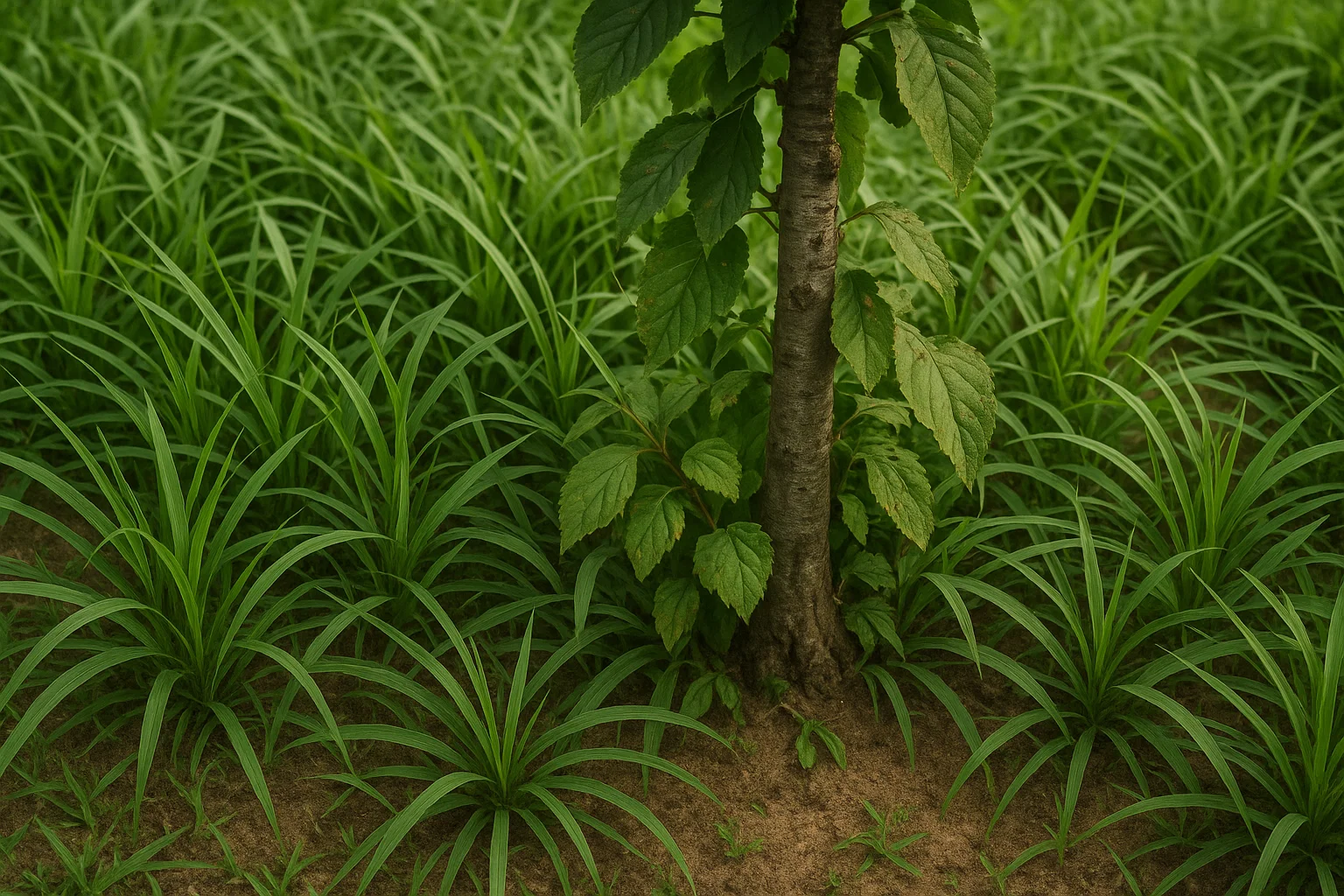
🍂 Creeping Jenny 🍂
This ground-hugging plant is a popular ornamental, but its invasive nature can quickly take over the area around your cherry tree. Creeping Jenny grows close to the ground and can prevent your tree from accessing nutrients and air.
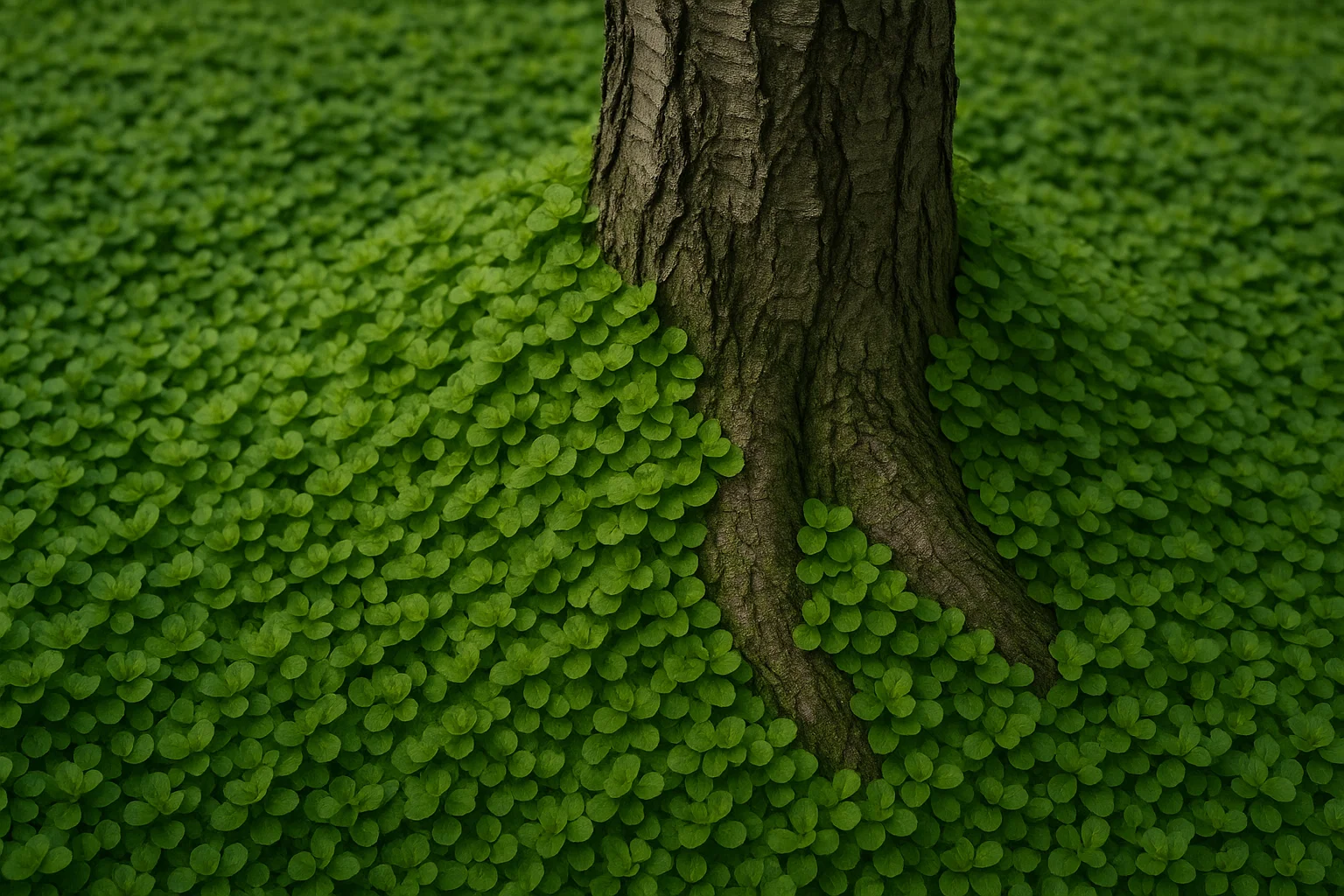
🌻 Bindweed 🌻
Bindweed is a persistent vine that climbs and wraps around tree trunks, branches, and nearby plants. Its strong tendrils can choke out your cherry tree, restricting growth and making it difficult to remove without damaging the tree.
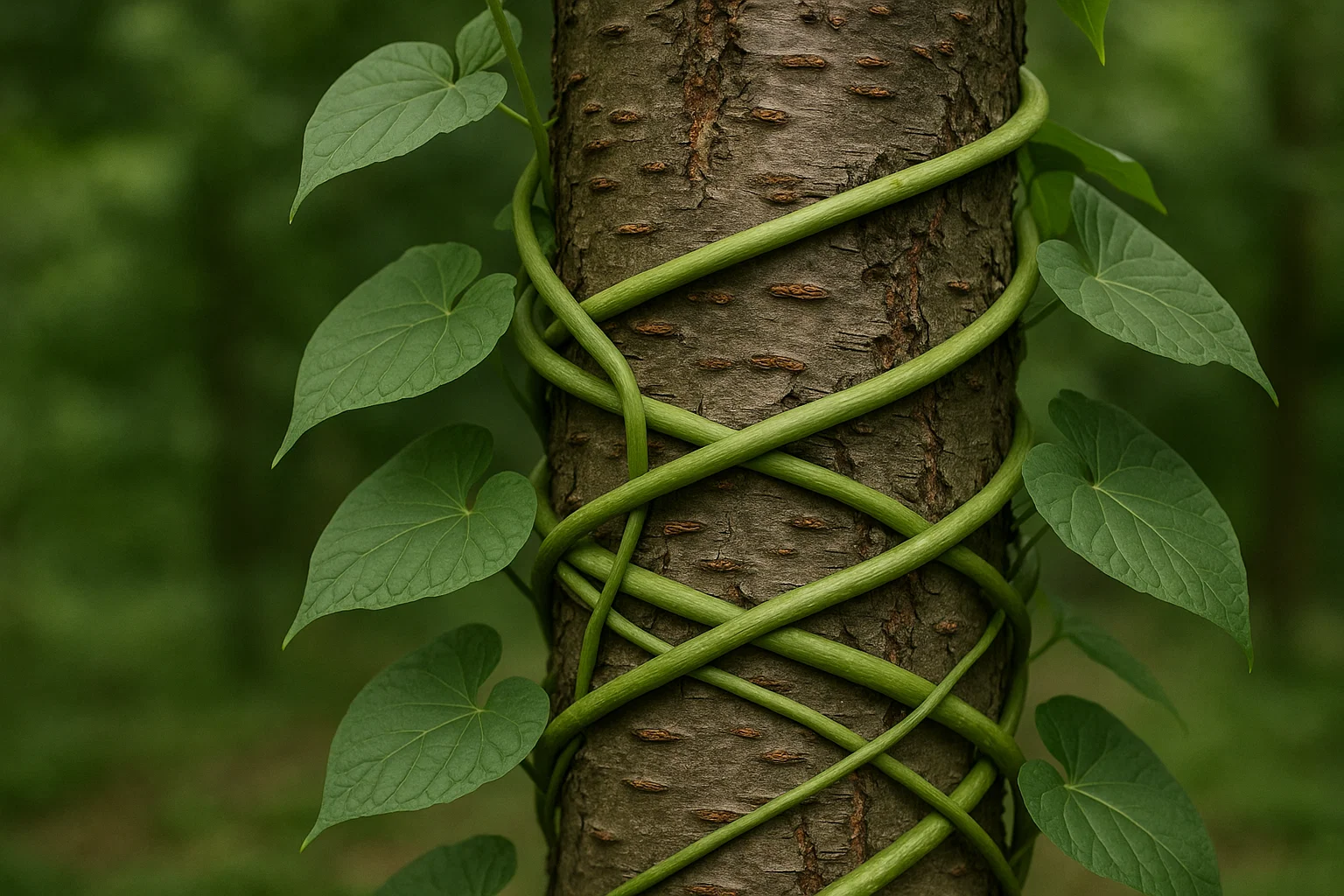
🌾 Nettle 🌾
Nettle’s stinging leaves make it an easy plant to recognize, but it can cause trouble in your garden by competing for water and nutrients. Nettles often thrive in moist soil, so check the area around your tree for any signs of growth.

🌱 Violets 🌱
Violets are pretty and harmless in small amounts, but they can spread rapidly and outcompete your cherry tree for space and sunlight, especially in shady areas. They’re also known to attract pests, which could harm your tree.

💡 How to Spot Weeds Early 💡
Weeds often grow faster than your cherry tree, so it’s important to act quickly. Look for any plants that spread aggressively, are crowding around the base of your tree, or seem to be thriving in places your tree is struggling. Early identification and removal of these weeds will help ensure your cherry tree gets the nutrients, sunlight, and space it needs to thrive.
By staying on top of these common weeds and overgrowth, you’ll give your cherry tree the best chance to grow healthy, strong, and productive! Mastering how to keep your cherry tree free from weeds and overgrowth is a crucial part of maintaining a thriving landscape. 🌳✨
🌿🚫🍒 Best Practices for Preventing Weed Growth 🍒🚫🌿
Preventing weeds from taking over your cherry tree’s space is far easier than dealing with them once they’ve spread. Here are some best practices to help keep your garden clear and your tree thriving:
🌸 Mulching 🌸
One of the most effective ways to prevent weeds is by applying a layer of mulch around the base of your cherry tree. Mulch acts as a barrier, blocking sunlight from reaching weed seeds and reducing their ability to grow. Organic mulches, like wood chips, bark, or straw, also improve soil health as they decompose. Apply a 2–4 inch layer, but be sure to keep it a few inches away from the trunk to prevent rot.
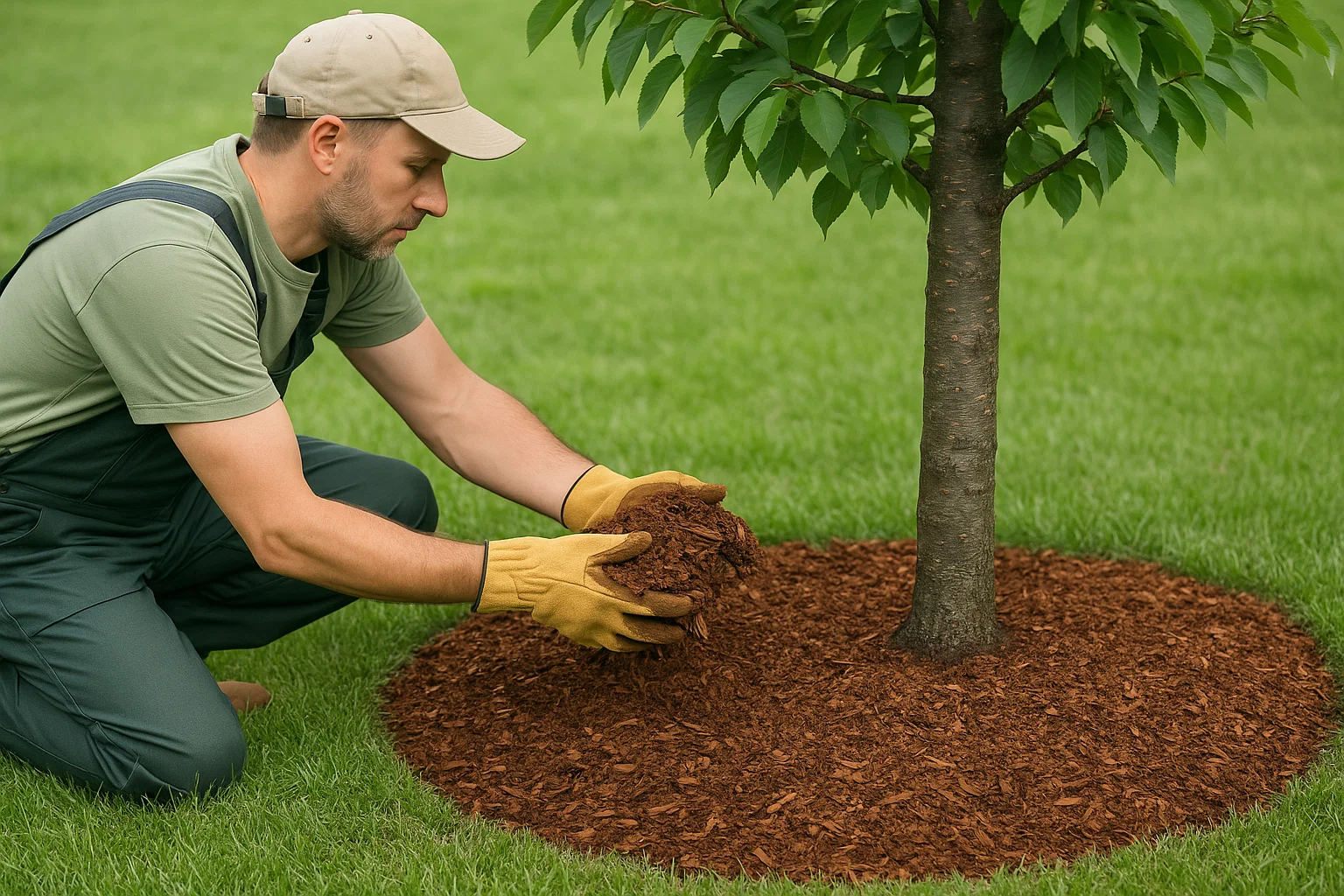
💧 Water Wisely 💧
Watering your cherry tree deeply but infrequently encourages the roots to grow deeper, making your tree stronger and better able to compete with weeds. Avoid overhead watering, which encourages shallow-rooted weeds to thrive. Focus on watering at the base of the tree to reduce moisture around nearby weeds.
🌞 Regular Weeding 🌞
Even with mulch, some weeds can sneak through. Regularly inspect the area around your cherry tree for any signs of unwanted growth. Hand-pulling weeds early, before they go to seed, is the best way to keep them under control. It’s easiest to remove weeds when the soil is moist and soft.
🌱 Improve Soil Health 🌱
Healthy soil is less prone to weed problems. Regularly aerating the soil around your cherry tree and adding organic matter (like compost) improves soil structure and increases its ability to resist weeds. Healthy soil also encourages your tree to grow strong and vigorously, making it better able to outcompete weeds.
🌿 Use Ground Covers 🌿
Planting low-growing ground covers that don’t compete with your cherry tree can help suppress weeds. Consider plants like clover or creeping thyme, which are not only pretty but can create a natural barrier to weed growth. Just make sure they don’t outgrow or overshadow your tree.
🌻 Pruning Surrounding Plants 🌻
Overgrown shrubs or plants near your cherry tree can create a microenvironment perfect for weeds. Regularly prune surrounding plants to reduce shade, allow more sunlight in, and limit the space weeds have to grow. Maintaining a clean and tidy space around your tree gives it room to breathe and thrive.
✨ Routine Maintenance ✨
A simple, consistent garden routine of mulching, watering, and weeding can go a long way in keeping your cherry tree free from weeds and overgrowth. By making weed prevention a part of your regular care, you’ll save time and effort in the long run and ensure that your tree remains healthy and productive.
By following these easy, effective practices, you can prevent weeds from becoming a problem and help your cherry tree grow strong and healthy for years to come! Learning how to keep your cherry tree free from weeds and overgrowth ensures that these efforts lead to lasting results.🍒🌳
🌿🧹🍒 Effective Weed Removal Techniques 🍒🧹🌿
When weeds do manage to pop up around your cherry tree, quick action is key. Here are some tried-and-true techniques to remove them safely and effectively:
🌱 Hand-Pulling Weeds 🌱
The simplest method is often the best! For small patches of weeds, hand-pulling can be very effective. Make sure to grab the weed at the base near the roots to avoid leaving any parts behind that could regrow. It’s easiest to do this after a rain or when the soil is moist.
🧤 Using the Right Tools 🧤
For tougher weeds or larger areas, consider using tools like a weed hoe, cultivator, or garden fork. These tools allow you to loosen the soil and remove weeds from the roots without disturbing your cherry tree’s roots. A hand weeder is also great for precision work around the tree trunk.
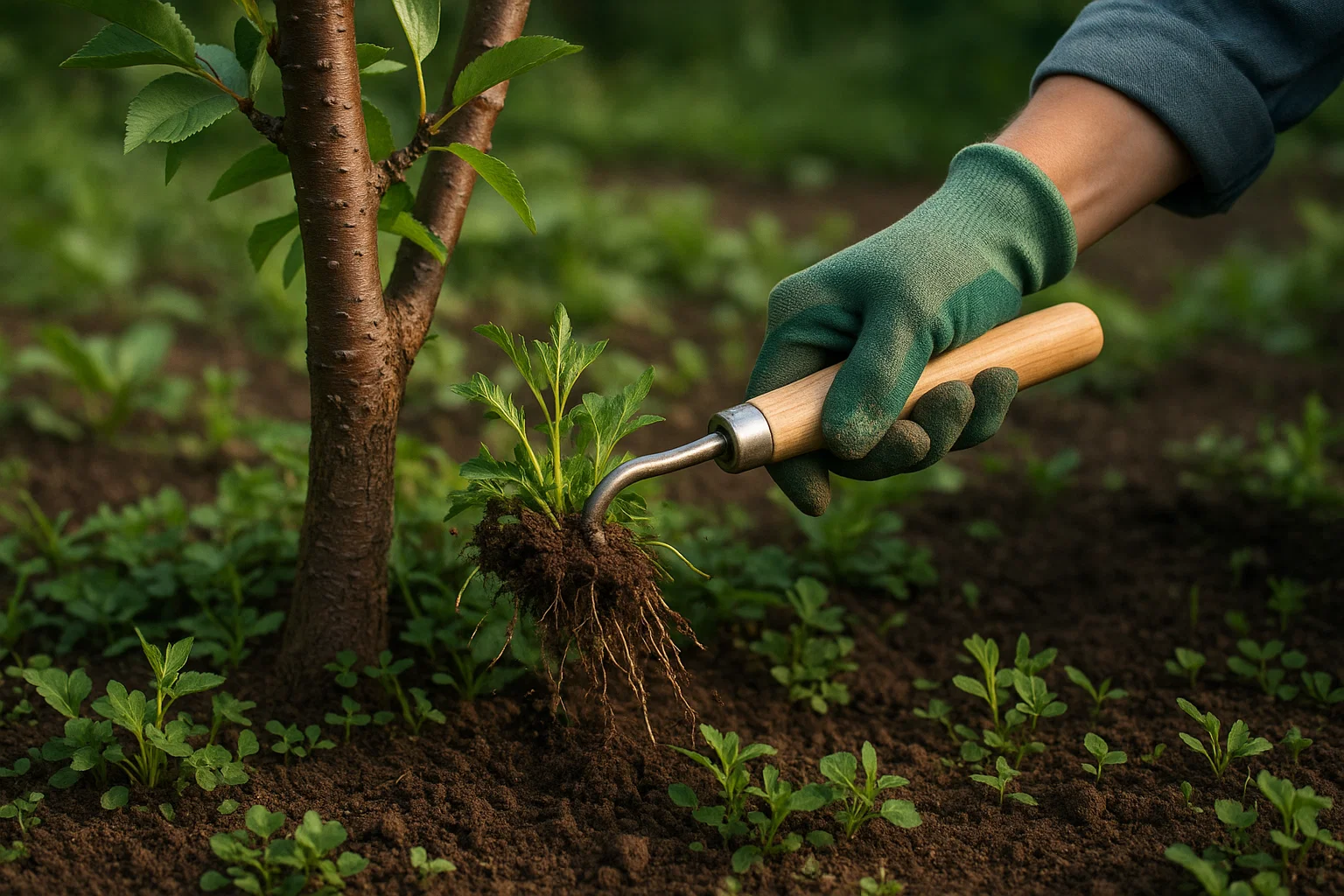
💧 Boiling Water 💧
Boiling water is a natural way to kill weeds without chemicals. Simply pour it directly onto the weeds, making sure not to splash it on your tree or other plants. This method works best for smaller patches of weeds and can be repeated as needed.
🍶 Vinegar Spray 🍶
White vinegar can be a powerful natural weed killer. Mix a solution of vinegar (about 20%) and water, and spray it directly onto the leaves of the weeds. Be careful to avoid spraying it on your cherry tree, as vinegar can harm it too. This method works best on sunny days when the sun helps dry out the weeds quickly.
🌱 Mulching After Removal 🌱
After you’ve removed the weeds, apply a fresh layer of mulch around your cherry tree. This helps prevent weeds from regrowing by blocking sunlight from reaching weed seeds. It also nourishes the soil, keeping it healthy for your tree.
🧹 Manual Weeding Tools 🧹
For stubborn or deep-rooted weeds, use a manual weeding tool such as a dandelion digger or weed puller. These tools are designed to help you dig up and remove weeds completely, roots and all, without disturbing the soil around your tree too much.
🌿 Solarization 🌿
For large weed-infested areas, you can try solarization, a method that involves covering the soil with clear plastic. The heat from the sun will cook the weeds and their seeds, rendering them unable to regrow. This method works best during the hottest months and can be especially effective for larger spaces.
💡 Tip: Weed Removal Timing 💡
The best time to remove weeds is when they are young and haven’t yet gone to seed. Weeds are easier to pull out when they are small, and removing them before they set seed will prevent them from spreading further.
By using these effective weed removal techniques, you’ll ensure your cherry tree has plenty of space and resources to grow strong and healthy. Keeping your garden free from weeds doesn’t have to be a chore when you use the right tools and methods! 🌳🍒
🌿🌸🍒 Using Ground Covers and Companion Plants 🍒🌸🌿
One of the best ways to prevent weeds while boosting your cherry tree’s health is by using ground covers and companion plants. These plants not only keep weeds in check but also provide other benefits like improving soil quality and attracting beneficial insects.
🌱 Ground Covers to Prevent Weeds 🌱
Ground covers are low-growing plants that spread out and form a dense mat, preventing weeds from taking root. Here are some great options:
- Clover: A popular ground cover that’s great for fixing nitrogen in the soil, clover also creates a natural, weed-blocking barrier.
- Creeping Thyme: Not only does creeping thyme look beautiful, but it also attracts pollinators like bees. It spreads quickly and helps keep weeds at bay.
- Pachysandra: A hardy evergreen ground cover that works well in shaded areas, providing both beauty and weed control.
- Sweet Woodruff: This fragrant ground cover grows well in both shade and sun, spreading quickly and preventing weed growth while adding a lovely scent to your garden.
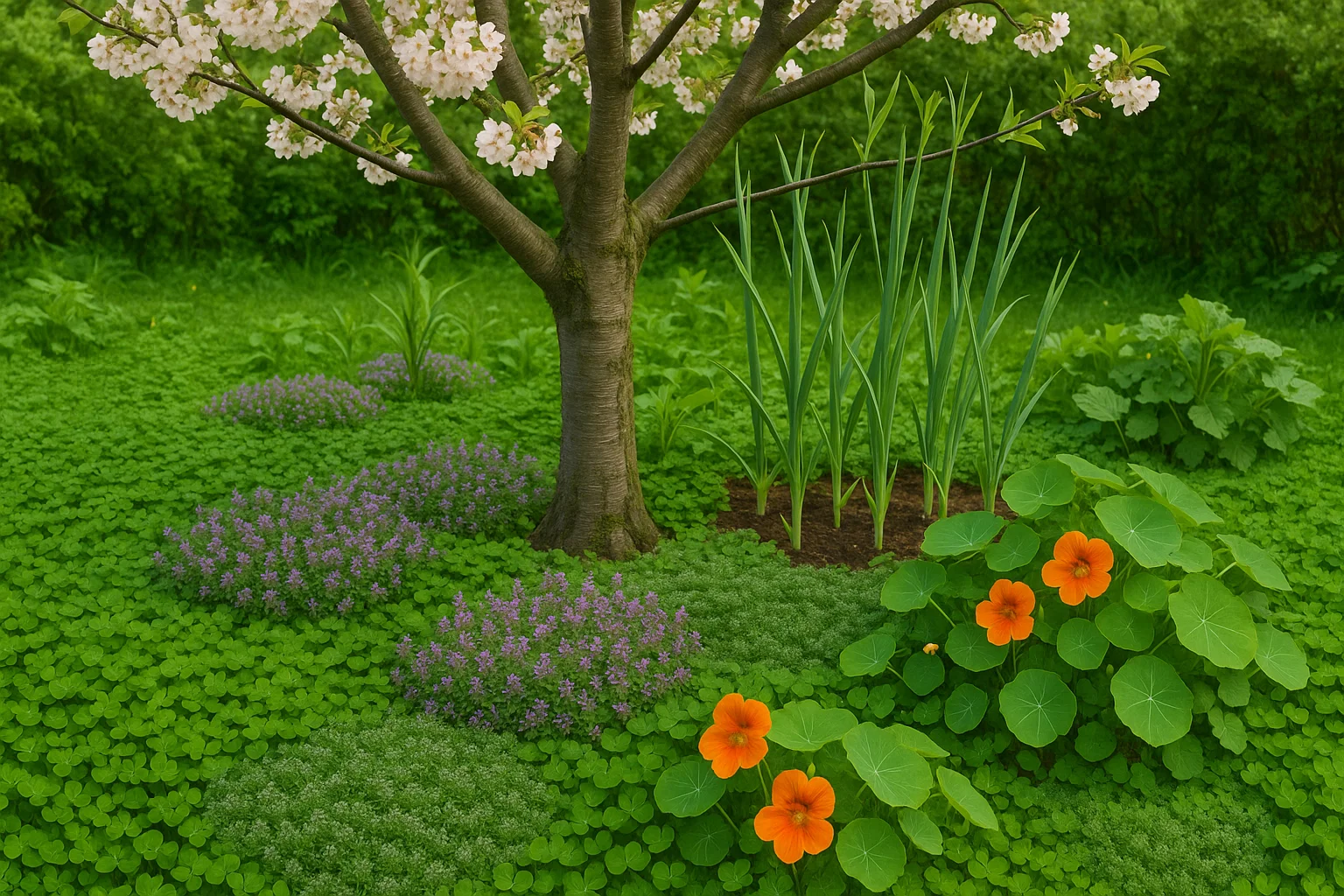
🌸 Companion Plants to Boost Cherry Tree Health 🌸
Companion planting involves pairing your cherry tree with plants that can support its growth or deter pests. Here are a few excellent companions:
- Garlic & Chives: These plants are natural pest repellents, especially against aphids and other bugs that might harm your cherry tree. They also help improve soil health.
- Nasturtiums: These vibrant flowers attract beneficial insects like ladybugs and also act as a natural deterrent for aphids, making them perfect for planting near your cherry tree.
- Comfrey: Comfrey is a fantastic plant for adding nutrients to the soil. Its deep roots bring up minerals, which are then made available to your cherry tree when the comfrey leaves are chopped and used as mulch.
- Marigolds: Known for their pest-repelling properties, marigolds can help protect your cherry tree from harmful insects like nematodes, aphids, and beetles.
🌿 Benefits of Ground Covers and Companion Plants 🌿
- Weed Control: Ground covers naturally suppress weed growth by blocking sunlight and competing for space.
- Improved Soil Health: Many companion plants, like clover, help enrich the soil with essential nutrients.
- Pest Prevention: Certain companion plants repel pests that might otherwise damage your cherry tree, reducing the need for chemical pesticides.
- Aesthetic Appeal: Ground covers and companion plants can add visual interest to your garden, creating a lush, vibrant environment around your cherry tree.
🌸 Tip: Choose ground covers and companions that match your garden’s conditions (sun, shade, moisture). This ensures both your cherry tree and the plants surrounding it will thrive!
Using ground covers and companion plants is an easy, natural way to improve your cherry tree’s health while keeping weeds under control. These plants work in harmony with your tree, offering protection, better soil, and even beauty to your garden. 🌳🍒🌿
🌿⚠️🍒 When and How to Use Herbicides Safely 🍒⚠️🌿
While natural methods like mulching and hand-pulling can be highly effective, sometimes you may need to use herbicides to tackle persistent weeds. However, it’s important to use them correctly to avoid harming your cherry tree or the surrounding environment. Here’s when and how to use herbicides safely:
🌱 When to Use Herbicides 🌱
Herbicides should be a last resort, used only when other methods haven’t worked or when weeds are overwhelming. Here are some situations where herbicides may be appropriate:
- Stubborn Weeds: If weeds like bindweed or crabgrass have taken over and manual removal is too time-consuming or ineffective, herbicides can help control them.
- Large Areas: If your cherry tree is surrounded by large patches of weeds that are difficult to manage by hand, herbicides may help clear the area.
- Selective Control: If you need to target specific weeds without affecting other plants, a selective herbicide can be used.
⚠️ How to Choose the Right Herbicide ⚠️
Not all herbicides are created equal, and choosing the right one is essential to protect your cherry tree:
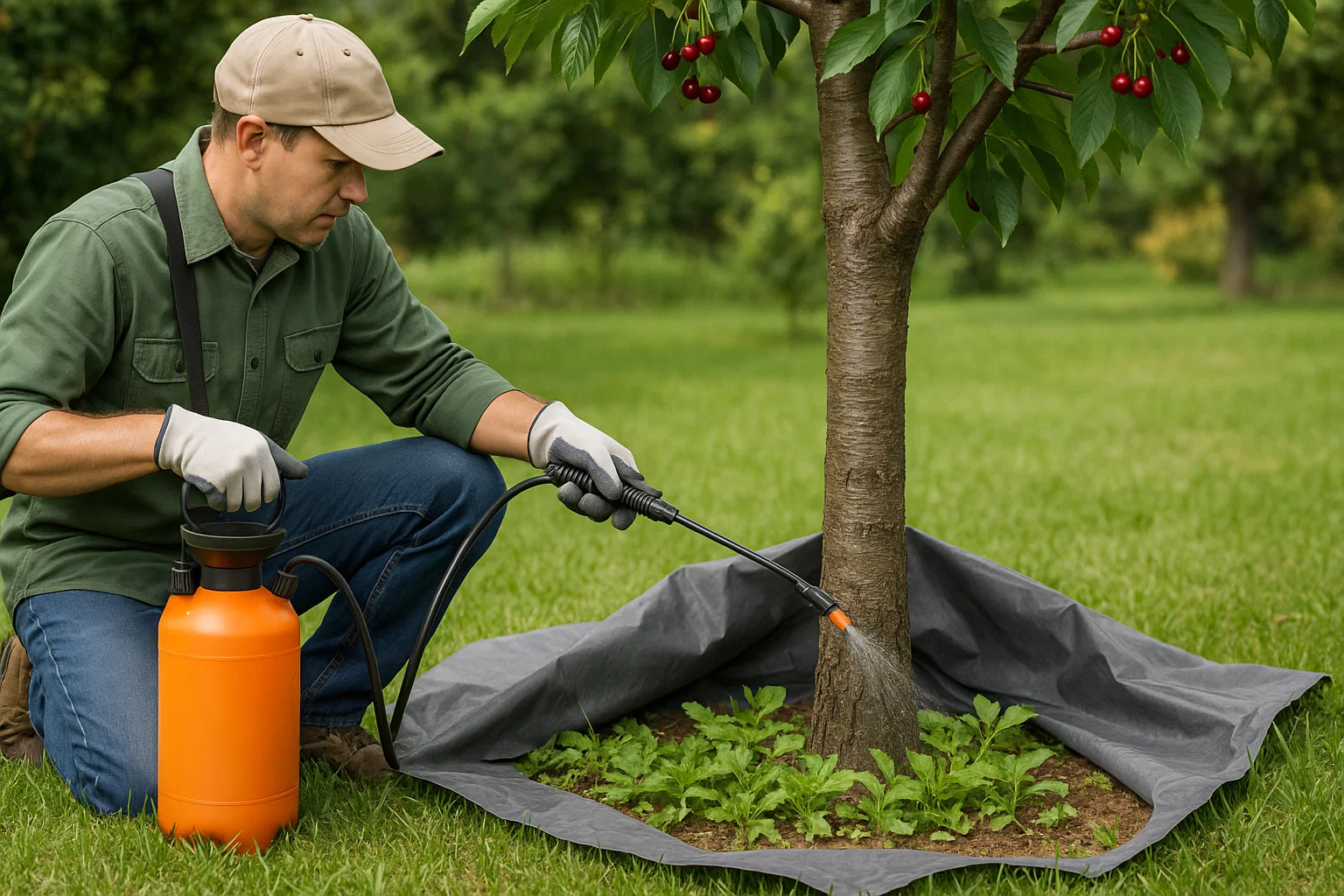
- Use Selective Herbicides: Look for herbicides that target only broadleaf weeds or grasses, depending on what you need to control. These are safer for your tree and other plants.
- Opt for Non-Toxic Options: Consider organic or natural herbicides made from ingredients like vinegar or citrus oil. These are less harmful to the environment and your plants.
- Avoid Systemic Herbicides: These can be absorbed by the soil and affect surrounding plants, including your cherry tree. Choose contact herbicides instead, which only affect the weeds they touch.
🌞 How to Apply Herbicides Safely 🌞
Follow these steps to apply herbicides with caution:
- Read the Label: Always read the herbicide label carefully to understand the proper usage and precautions. Follow the recommended dosage and timing instructions.
- Protect Your Tree: Keep the herbicide away from the trunk and branches of your cherry tree. You can shield the tree with a tarp or cardboard when spraying around the base.
- Apply During Dry, Calm Days: Apply herbicide on a dry, windless day to prevent it from drifting onto your tree or other plants.
- Use a Spot Treatment: Instead of spraying broad areas, apply herbicide directly to the weeds using a sprayer or sponge. This minimizes the risk of damage to surrounding plants.
- Wait for Absorption: Allow the herbicide to fully dry before watering or touching the area to prevent it from being washed away or absorbed by other plants.
🌿 Alternatives to Herbicides 🌿
If you’re looking to avoid chemicals entirely, try these alternatives:
- Natural Weed Killers: Use vinegar, salt, or boiling water for a more natural approach.
- Preventive Measures: As mentioned earlier, mulching and using ground covers can be just as effective, with no chemicals involved.
🌱 Tip: If you’re ever unsure about using herbicides, try contacting a local gardening expert for advice on which products are safe and effective for your area.
By using herbicides carefully and only when necessary, you can control weeds without putting your cherry tree’s health at risk. Always prioritize natural methods first, and reserve herbicides as a controlled, last resort for tough weeds. Knowing how to keep your cherry tree free from weeds and overgrowth helps you make smarter choices about when and how to use chemical solutions.🌳🍒
✂️🌿🍒 Pruning and Trimming for Overgrowth Control 🍒🌿✂️
Pruning and trimming your cherry tree and surrounding plants is essential for controlling overgrowth and ensuring healthy growth. Regular maintenance not only keeps your tree looking neat but also helps it thrive by improving air circulation, sunlight exposure, and space for new growth. Here’s how to effectively prune and trim for overgrowth control:
🌿 Why Pruning Matters for Overgrowth Control 🌿
Pruning your cherry tree and nearby plants reduces the chances of overcrowding, which can lead to poor air circulation and increased risk of pests or diseases. Trimming excess growth also helps your tree focus its energy on producing strong branches and healthy fruit.
✂️ Pruning Your Cherry Tree ✂️
- Start with Dead or Diseased Wood: Begin by removing any dead, damaged, or diseased branches. These are not only unattractive but can also attract pests and spread disease.
- Thin Out the Interior: Remove any interior branches that cross each other or are growing toward the center of the tree. This allows more light and air to reach the inner parts of the tree, helping to promote healthy growth.
- Shape the Tree: Keep the tree’s shape open and balanced by cutting back any long, spindly branches that disrupt the natural shape. Aim for a structure that allows sunlight to reach all parts of the tree.
- Cut Back Lateral Growth: Trim any lateral (side) shoots that are growing too far out, especially if they’re crowding the space around the base or competing with the tree’s main branches.
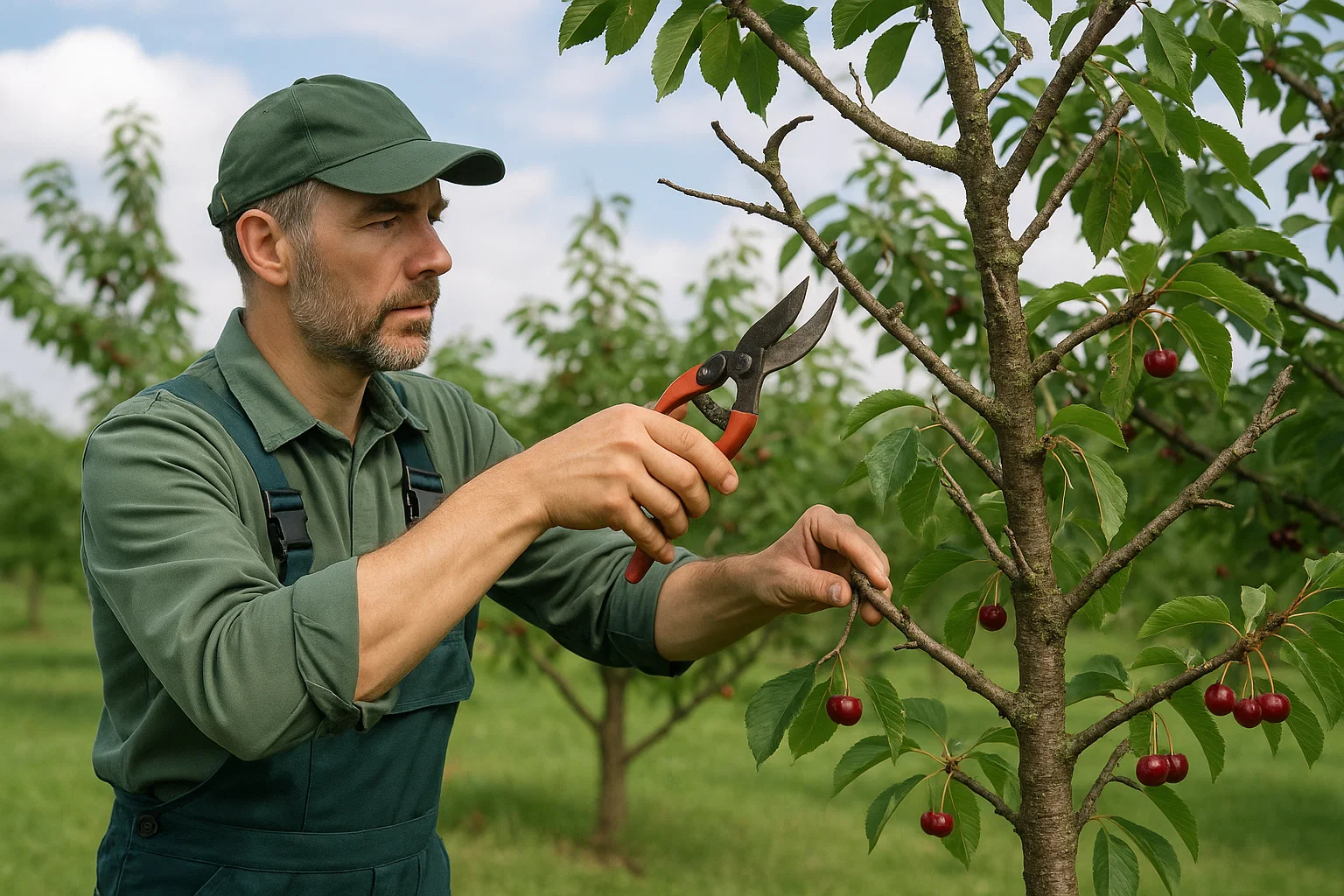
🌿 Trimming Surrounding Plants 🌿
Keep surrounding shrubs and plants trimmed to prevent them from overshadowing or crowding your cherry tree. Overgrown plants can block sunlight, reduce airflow, and even compete for nutrients. Here’s how to trim nearby plants:
- Remove Overhanging Branches: If nearby trees or shrubs have branches that hang over your cherry tree, trim them back to allow your tree to get more light.
- Thin Dense Shrubs: If you have shrubs growing near your cherry tree, thin them out by removing the oldest stems and cutting back any growth that’s too close to the tree. This helps prevent unwanted shading and creates more space for your cherry tree to grow.
- Control Ground Cover: If you’re using ground covers like clover or creeping thyme, make sure they don’t overrun the base of your cherry tree. Trim back any runners that are creeping too close to the trunk or competing with your tree’s roots.
🌞 Best Time to Prune and Trim 🌞
- Prune in Late Winter or Early Spring: The best time to prune your cherry tree is during its dormant period (late winter or early spring) before new growth begins. This reduces stress on the tree and allows it to heal quickly.
- Trim Surrounding Plants Regularly: For shrubs, ground covers, and other nearby plants, regular trimming throughout the growing season (spring to late summer) ensures they don’t become invasive or outgrow their space.
🌱 Tip: Always use clean, sharp pruning shears to avoid damaging your tree or plants. When pruning large branches, make clean cuts at a slight angle to prevent water buildup that could cause rot.
By consistently pruning and trimming your cherry tree and the plants around it, you can keep overgrowth in check and ensure your tree gets the sunlight, space, and air circulation it needs to thrive. Healthy pruning promotes strong growth, better fruit production, and a more beautiful garden overall. 🌳🍒✨
🌿🌞🍒 Seasonal Weed Management Tips 🍒🌞🌿
Weed management is an ongoing task, but how you approach it can change with the seasons. Different weeds grow at different times of the year, so adjusting your strategy accordingly is key to keeping your cherry tree free from overgrowth. Here are seasonal tips for managing weeds around your cherry tree:
🌸 Spring: Early Weed Prevention 🌸
Spring is a critical time for weed management as it marks the start of the growing season. Weeds are starting to sprout, and getting ahead of them will save you time and effort later.
- Mulch Early: Apply a thick layer of mulch around the base of your cherry tree to prevent weed seeds from germinating. This will help smother early weeds and keep moisture in the soil for your tree.
- Hand-Pull Small Weeds: As weeds begin to sprout, hand-pulling is effective while they are still small and easier to remove. This is the best time to target young, shallow-rooted weeds before they take hold.
- Check for Root Growth: In early spring, check the area around your tree for any perennial weeds that might be regrowing from roots. Remove them promptly to prevent further spread.
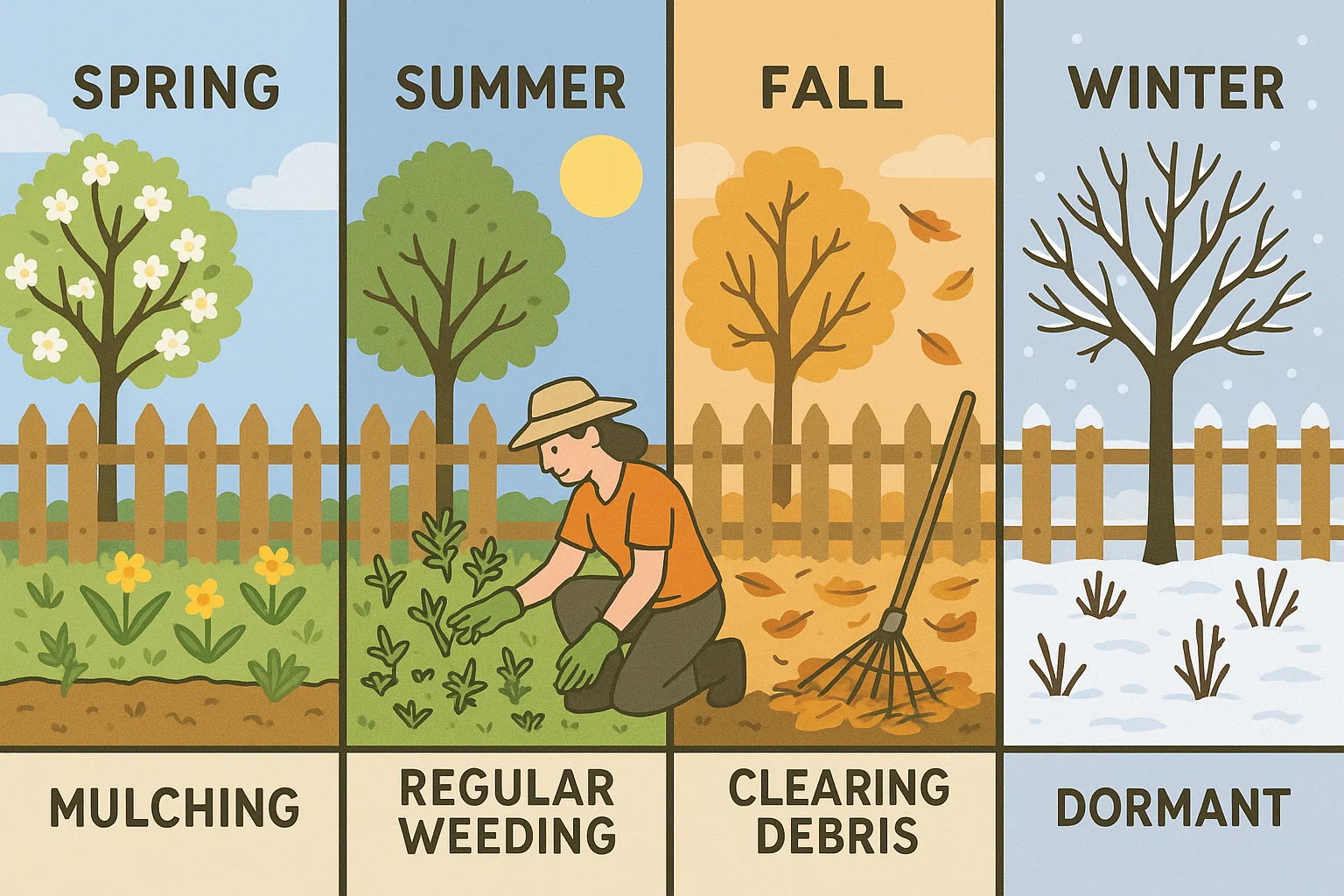
☀️ Summer: Active Weed Control ☀️
Weeds tend to thrive in the warm months, so keeping on top of them during summer is essential. At this point, some weeds may have established deep roots, so you’ll need more proactive methods.
- Weed Regularly: Summer heat encourages rapid weed growth, so make sure to regularly check and remove any weeds. Use tools like a hoe or garden fork to get rid of larger or deeper weeds.
- Water Effectively: Weeds thrive when there’s too much moisture on the surface. Water your cherry tree deeply and infrequently to encourage deeper root growth while keeping the surface drier, making it less inviting for weeds.
- Reapply Mulch: As mulch breaks down during the summer, apply a fresh layer to keep weeds at bay. This helps keep your tree’s roots cooler and limits weed competition for nutrients.
🍂 Fall: Prepare for the Coming Year 🍂
Fall is an ideal time to deal with perennial weeds and set your cherry tree up for a weed-free winter. By focusing on fall weed control, you’re preventing next spring’s weed problems.
- Remove Fallen Weeds and Debris: Remove any weeds that have gone to seed or fallen to the ground. This helps prevent the spread of seeds and reduces the chances of them sprouting next spring.
- Use Herbicides if Necessary: If you have a particularly bad weed problem that hasn’t been controlled with other methods, fall is a good time to apply a targeted herbicide. Make sure to follow instructions carefully to avoid harming your cherry tree.
- Cover Bare Soil: If you’ve removed weeds and have bare soil around your tree, consider adding another layer of mulch or planting a cover crop like clover. This prevents weeds from taking root and gives your soil a nutrient boost.
❄️ Winter: Rest and Preventative Measures ❄️
Winter is the dormant season for your cherry tree, and while weeds are less active, there are still steps you can take to prepare for the coming months.
- Clean Up: Clear the area around your cherry tree of any remaining weeds, leaves, or plant debris. This helps reduce the chances of pests or diseases taking root during the winter.
- Maintain Your Mulch: Ensure that your mulch layer is thick enough to prevent any winter weeds from sprouting. If it’s too thin, replenish it before the cold sets in.
🌱 Tip: Keep a seasonal weed calendar for your garden. Track when specific weeds tend to appear and plan ahead for each season. This proactive approach will save you time and frustration.
By adjusting your weed management techniques throughout the year, you’ll make it much easier to keep your cherry tree healthy and thriving, free from the competition of weeds. Understanding how to keep your cherry tree free from weeds and overgrowth is key to ensuring long-term success in your garden. 🌳🍒🌿
🌿🌳🍒 Bonus Tips for Long-Term Maintenance 🍒🌳🌿
Maintaining a healthy, weed-free environment for your cherry tree is a long-term commitment. With a few additional tips, you can make ongoing care easier and more efficient, ensuring your tree stays healthy, productive, and strong for years to come.
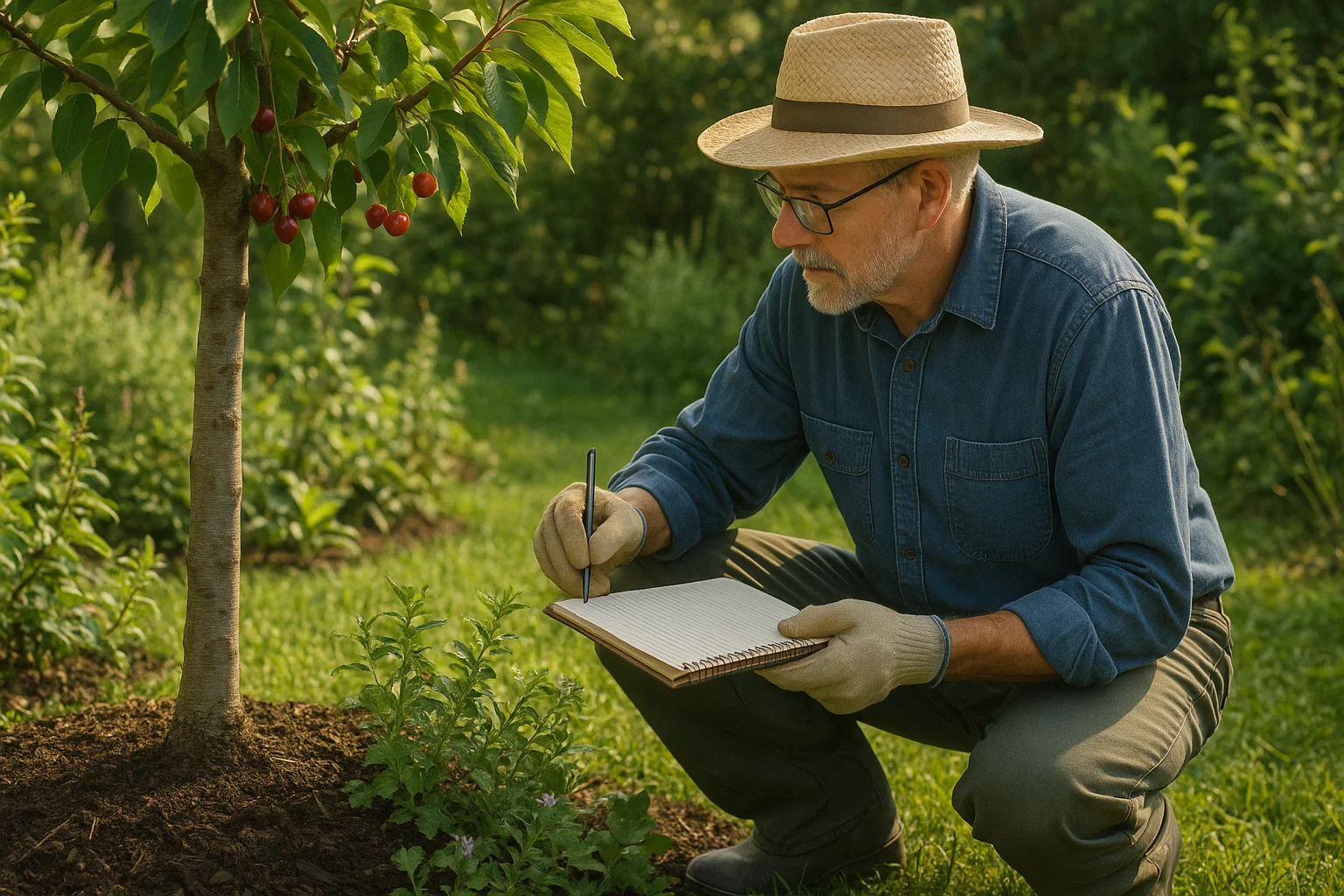
🌱 Keep Your Soil Healthy 🌱
Soil health is the foundation of a thriving cherry tree. Poor soil can lead to weak tree growth, which can make it more susceptible to weeds.
- Add Organic Matter: Regularly incorporate compost or organic fertilizers into the soil to keep it rich in nutrients. Healthy soil helps your cherry tree grow stronger and outcompete weeds for resources.
- Aerate the Soil: Aerating the soil around your cherry tree once a year helps improve root growth and water penetration, which can also reduce weed establishment.
🌞 Mulch Year-Round 🌞
Mulch isn’t just for the spring—it can be beneficial throughout the year.
- Replenish Mulch Annually: Add a fresh layer of mulch each year to maintain its weed-suppressing benefits and help retain moisture in the soil.
- Use Organic Mulch: Opt for organic materials like wood chips, straw, or leaves. These decompose over time, enriching the soil, and helping your cherry tree thrive.
🌿 Keep Your Tree Strong and Healthy 🌿
A well-cared-for cherry tree will naturally fend off pests and weeds more effectively.
- Fertilize Properly: Feed your tree with a balanced fertilizer at the beginning of the growing season to support healthy growth. Over-fertilizing can encourage excessive growth, so be sure to follow guidelines.
- Monitor Tree Health: Regularly inspect your cherry tree for signs of pests, diseases, or nutrient deficiencies. A healthy tree is more resilient to weeds and other garden challenges.
🍂 Plan for Regular Pruning 🍂
Regular pruning isn’t just for controlling overgrowth—it also helps your cherry tree stay healthy and reduces the chances of weed-friendly conditions.
- Prune Annually: Make it a habit to prune your tree each year during its dormant season (late winter or early spring). This keeps the shape neat and encourages strong, productive branches.
- Remove Competing Growth: Trim any competing growth from nearby plants that could shade your tree or steal nutrients and water.
🌻 Stay on Top of Weeding 🌻
Consistency is key when it comes to weed control.
- Weed Early and Often: Regularly check your garden for weeds, especially during the growing season. It’s easier to control them when they’re small and haven’t spread.
- Root Removal: When pulling weeds, always try to remove the roots to prevent regrowth. For perennial weeds, this is especially important.
🌳 Use Natural Weed Barriers 🌳
If you prefer an eco-friendly approach, consider adding permanent weed barriers around your cherry tree.
- Landscape Fabric: Lay down landscape fabric underneath mulch to prevent weeds from growing through. It’s a long-lasting solution that doesn’t harm the soil or environment.
- Living Barriers: Ground covers like clover or creeping thyme create natural weed barriers that are visually pleasing and reduce maintenance.
🌞 Avoid Overwatering 🌞
Overwatering can lead to soggy soil, which encourages weed growth and root rot.
- Water Deeply but Infrequently: Water your cherry tree deeply but less often to encourage strong, deep roots. Shallow watering can cause weeds to grow quickly, especially on the surface.
💡 Stay Informed and Flexible 💡
Gardening is always evolving, and so is your approach to tree care.
- Stay Updated: Regularly research best practices for cherry tree maintenance, new pest or weed issues in your area, and organic care tips.
- Be Adaptable: As you gain experience with your tree and garden, adjust your methods to better suit the needs of your cherry tree and local growing conditions.
🌱 Tip: Keep a gardening journal! Document your tree’s growth, the types of weeds you’ve encountered, and the methods that worked best. It’s a great way to learn and improve year after year.
By following these bonus tips for long-term maintenance, you’ll ensure your cherry tree remains healthy and productive while keeping weeds and overgrowth at bay. One essential aspect of care is learning how to keep your cherry tree free from weeds and overgrowth, which supports better growth and overall tree health.🌳🍒🌿
🌳🍒 Final Thoughts 🍒🌳
Maintaining a healthy cherry tree free from weeds and overgrowth is essential for its growth and fruit production. By following the right practices, such as mulching, pruning, and using ground covers, you can create an environment that supports your tree’s health while keeping weeds at bay. Regular attention to your tree’s needs, along with seasonal weed management, ensures long-term success.
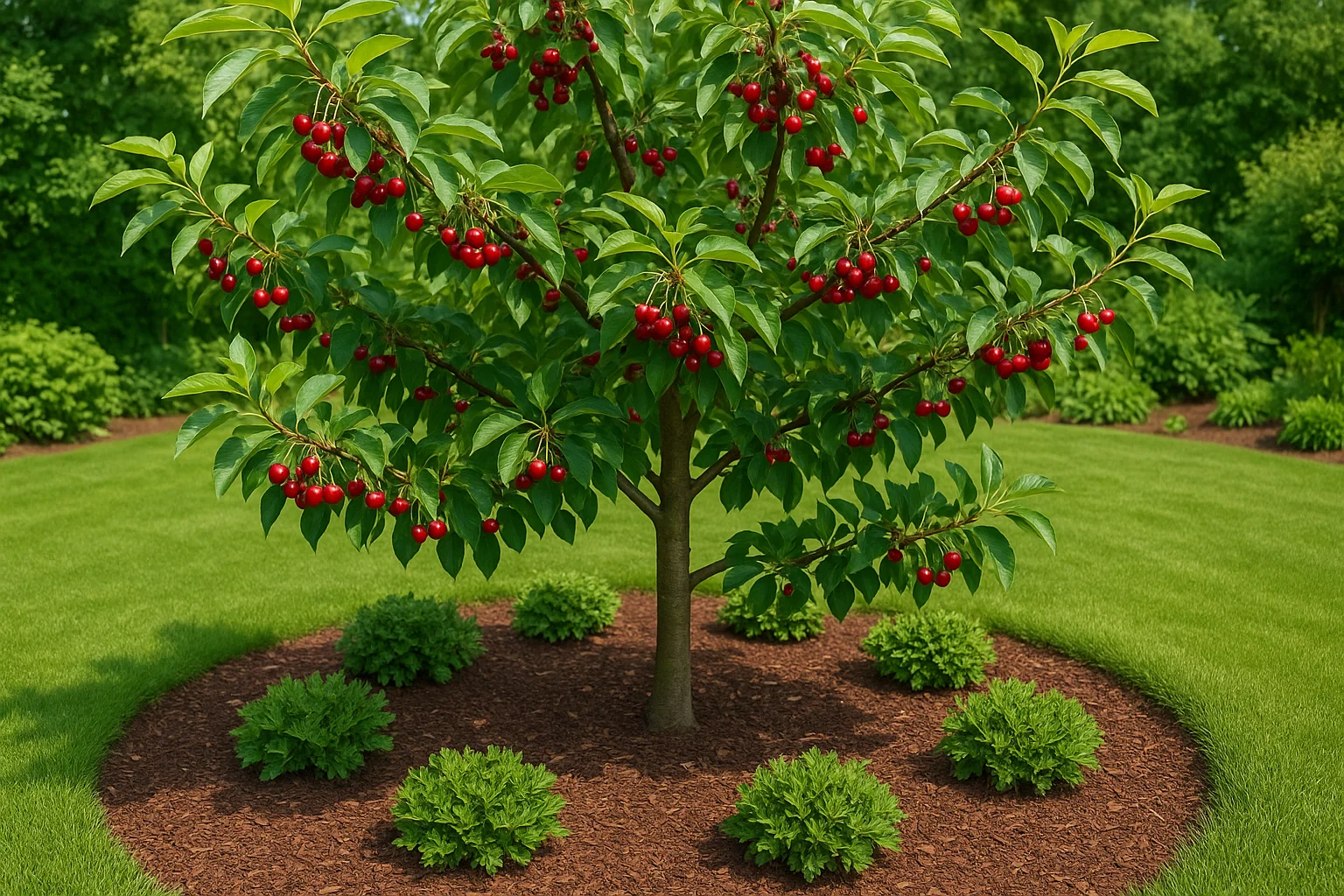
With these proven tips, you’ll have a thriving, productive cherry tree and a beautiful, weed-free garden for years to come. Happy gardening! 🌿🍒🌞
Frequently Asked Questions (FAQ)
Why is it important to keep my cherry tree free from weeds and overgrowth?
Weeds and overgrowth compete with your cherry tree for nutrients, water, and sunlight, reducing fruit yield and tree health.
What is the best method to prevent weeds around a cherry tree?
Mulching with organic material like bark or straw is one of the most effective ways to suppress weeds naturally.
How often should I check for weeds and overgrowth near my cherry tree?
Check weekly during the growing season to catch weeds early before they become established.
Can overgrowth harm my cherry tree’s roots or trunk?
Yes, dense overgrowth can trap moisture and cause rot, pest infestations, or disease near the trunk and roots.
Is it safe to use herbicides around my cherry tree?
Use only selective, tree-safe herbicides with caution, and always follow label instructions to avoid damaging the tree.
How much mulch should I apply around a cherry tree to prevent weeds?
Apply a 2–4 inch layer of mulch, keeping it a few inches away from the trunk to prevent rot.
Are there natural weed control options for cherry trees?
Yes, options include hand-pulling, vinegar sprays, and planting ground cover that doesn’t compete heavily for nutrients.
What signs indicate my cherry tree is stressed due to weeds and overgrowth?
Look for yellowing leaves, poor fruit production, and slowed growth as signs of competition from nearby weeds.
